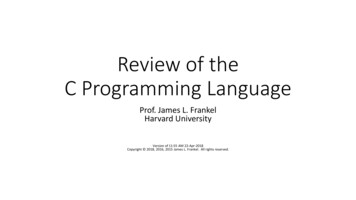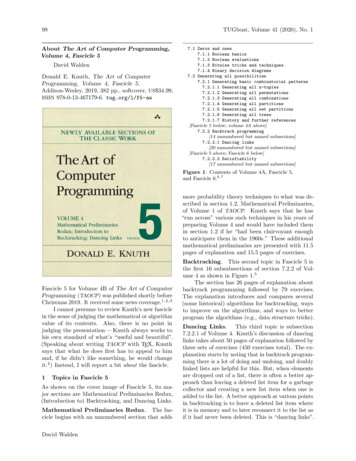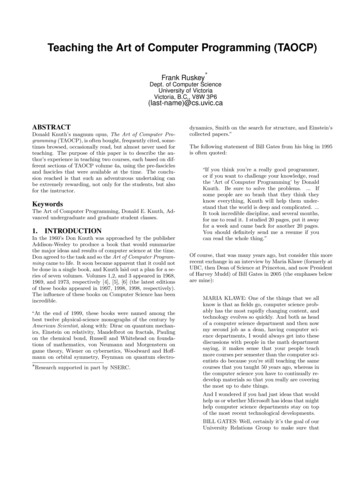
Transcription
Review of theC Programming LanguageProf. James L. FrankelHarvard UniversityVersion of 11:55 AM 22-Apr-2018Copyright 2018, 2016, 2015 James L. Frankel. All rights reserved.
Reference Manual for the Language Required textbook C: A Reference Manual, Fifth Edition by Harbison & Steele Has all details of the language This is a necessary reference to be able to implement a compiler forthe language
Concepts of Language Design and Usage This presentation contains many concepts of computer languagedesign and usage These concepts are very important in understanding computerlanguages and also how compilers work Feeling at ease with many of these concepts is important to be ableto successfully implement a compiler This presentation basically follows C89, but may contain somelanguage features that are not present in C89 Not all C89 language features described in this presentation are partof the language accepted by our class project
Language: Lexical Elements (§2) Character Set Comments Tokens Operators and Separators Identifiers Keywords Constants
Language: Operators Operators perform operations For example, the “ ” (simple assignment) operator stores the value obtainedby evaluating the right-hand-side operand into the location designated by theleft-hand-side operand Operators produce results For example, the result of the “ ” (simple assignment) operator is the valueobtained by evaluating the right-hand-side operand after being converted tothe type of the left-hand-side operand Observation: both unary prefix and unary postfix will incrementtheir operand; the difference is the value of the result of the operator
Unary, Binary, and Ternary Operators Operators may take one, two, or three operands Unary operators take one operand Binary operators take two operands The ternary operator takes three operands
Prefix, Infix, and Postfix Operators Operators that precede their operand are prefix operators Operators that appear between their operands are infix operators Operators that follow their operand are postfix operators
Expression Parsing Expressions are parsed into a tree-like structure For example, the following expression a b / c results in thefollowing tree a/bc
Expression Evaluation When an expression is evaluated, the top-level operator is executed Nested operators are evaluated as determined by the top-leveloperator in the expression Most operators evaluate all their operands Some operators evaluate some of their operands as determined by otheroperands Take a look at the “short-circuit” operators: && and Also, look at the ternary conditional operator
“As If” Behavior The language stipulates how operators, expressions, statements, etc.behave The compiler must implement those rules However, the compiler is free to not strictly follow those rules if theprogram cannot determine whether the rule was followed or not. This iscalled “as if” behavior because the compiler acts as if all the rules werefollowed. For example, if a program cannot determine if an expression was evaluatedor not (i.e., the evaluation of the expression does not effect the state of theprogram – that is, the result is not needed and there are no side effects),then the compiler does not need to evaluate that expression
Unary Prefix Operators Increment and decrement - Size sizeof Yes, sizeof is an operator! When are parentheses needed? What is the value of sizeof array when array is declared as int array[20] and int’s arefour bytes in length? Bitwise not Logical not !Arithmetic negation and plus - Address of &Indirection *Casting ( type-name ) Because of the matching parentheses, this is defined as a unary operator
Unary Postfix Operators Subscripting a[k] Because of the matching brackets, this is defined as a unary operator Function Call f( ) Because of the matching parentheses, this is defined as a unary operator Direct Selection . Indirect Selection - Increment and decrement --
Binary Infix Operators Multiplicative * / % Additive Left and Right Shift Relational Equality/Inequality ! Bitwise & Logical && Assignment - * / % & Sequential Evaluation ,
Logical Operands and Results Operators that evaluate operands for logical values accept 0 to signifyfalse or any non-zero value to signify true These operators are !, &&, , and the first operand of ? : Operators that produce a logical result always result in either 0 (forfalse) or 1 (for true) These operators are !, &&, , , , , , , ! No value other than 0 or 1 will be the result of these operators Following the “as if” rule, if the result of these operators is not used as anumeric value, but is used directly in another way (say, as the condition in anif statement), then the true or false result may result in conditional branchingbut not in a 0 or 1 value
Details of the Binary Infix Logical Operators The && and operators always evaluate their left-hand operand, but onlyevaluate their right-hand operand when needed to determine the result ofthe operator; this is sometimes referred to as short-circuit behavior To be clear, these operators are not allowed to evaluate their right-handoperands when not needed to determine the result of the operator That is, the && operator will evaluate its right-hand operand only when itsleft-hand operand evaluates to true (non-zero) The operator will evaluate its right-hand operand only when its lefthand operand evaluates to false (zero) As for all operators, the “as if” rule applies
Ternary Infix Operator Conditional operator ? : Example a?b:c If a is true, b is evaluated and returned as the result of the conditional operator If a is false, c is evaluated and returned as the result of the conditional operator To be clear, this operator is not allowed to evaluate the operand that is notrequired in the description above As for all operators, the “as if” rule applies
Associativity (§7.2.1) Operators of degree greater than one (i.e., with more than one operand) may beeither left- or right-associative Associativity determines how operators of the same precedence level aregrouped when parentheses are not present In the C Programming Language, all binary operator are left-associative except forthe assignment operators (includes both simple and compound assignmentoperators) In the C Programming Language, the ternary operator (the conditional operator)is right-associative See Table 7-3 on page 205 in Harbison & Steele Of course, it is possible to specify associativity by using parentheses
Associativity Examples Left-associativity examples a – b – c is equivalent to ((a – b) – c) Right-associativity examples a b c is equivalent to (a (b c)) a ? b : c ? d : e is equivalent to (a ? b : (c ? d : e))
Precedence(§7.2.1) Precedence determines how operators of different precedence levelsare grouped when parentheses are not present For example, because multiplicative operators have higherprecedence than additive operators and because they both havehigher precedence than assignment operators (and because additiveoperators are left-associative), a b c*d eis evaluated as if fully parenthesized as follows(a ((b (c * d)) e)) See Table 7-3 on page 205 in Harbison & Steele
Overloading (§4.2.4) Overloading is the principle that the same symbol (including operators andidentifiers) may have more than one meaning For example, the – operator is used both as a unary prefix operator andalso as a binary infix operator Overloading may also be determined by type For example, the – operator is used both for integral subtraction and for floatingpoint subtraction. These operations are very different even though they have similarmathematical principles that serve as their inspiration Overloading may also be determined by context void as a pointer target type means pointer to anything void as the return value in a function declaration means no return value void as the sole type in a cast means discard the value of the expression
Computer Language Operators are Not theSame as Mathematical Operators Keep in mind that operators in computer languages are not the sameas the similar operator in mathematics Several reasons for dissimilarity In mathematics, the number of integral values is infinite – that is, the range ofpositive and negate integers is unlimited Computers’ integers are constrained in range In mathematics, real numbers are used to represent any real value – that is,they have unlimited range and precision (accuracy to any number of decimalplaces) Computers’ floating-point numbers are constrained in both range and precision and, inaddition because of their internal representation, computers may not be able exactlyrepresent a real value
Type Each constant, identifier, sub-expression, and expression has a type A type describes the kind of values that are able to be represented Taxonomy of types Scalar types Arithmetic types Integral types: char, short, int, longFloating-point types: float, double, long doublePointer types Aggregate types Array typesStructure types Union types Function types Void types The language has a means to declare a type – this is a declaration The type description in a declaration is called a declarator The language has rules to describe how types are used
Use of Types Some operators may accept operands of a limited subset of types The function of an operator may be determined by the type(s) of theoperands For example, binary addition is very different for integral values and forfloating-point values because they have very different internalrepresentations The type of the result of an operator may be determined by thetype(s) of the operands Overall, we call this the “type calculus”
Lvalues vs. Rvalues (part 1 of 2) Some expressions can be used to refer to locations in memory Examples aarray[i]node.fieldThese are lvalues Other expressions represent values Examples (in addition to those above) a*bfunct(a, b, c)These are rvaluesAll lvalues can represent rvalues, but not all rvalues can represent lvalues a 1 2; Because of associativity and precedence, this is the same as (a (1 2));The result of the operator (adding 1 and 2 in this expression) is not an lvalue It cannot be used to refer to the location of an operand, therefore For example, it cannot appear on the left-hand-side of an assignment operator(1 2) a;
Lvalues vs. Rvalues (part 2 of 2) The description of each operator in Harbison & Steele includes information asto Whether each operand must be an lvalue (or if an rvalue is acceptable) Whether the result of the operator may be used as an lvalue (or if it may be used solely inthose instances that require an rvalue) Examples Assignment operators The lhs (left-hand side) must be a modifiable lvalue The result is never an lvalue Address-of operator The operand must be either a function designator or an lvalue designating an object The result is never an lvalue Indirection operator The operand must be a pointer If the pointer points to an object, then the result is an lvalue referring to the object
Layout of Multidimensional Arrays in Memory In C, multidimensional arrays are stored in row-major order (i.e., adjacentelements in memory differ by one in their last subscript) Thus, a 2-by-3 array of int (two rows, three columns) declared asint matrix[2][3]; would be laid out in memory matrix[1][1]matrix[1][2]
Language: Declarations (§4) Restriction on Where Declarations Can Appear Storage Class and Function Specifiers Storage class: auto, extern, register, static, typedef Type Specifiers and Qualifiers Qualifiers: const, volatile, restrict (C99) Declarators Initializers External Names
Scope (§4.2.1) Identifiers are declared in nested scopes Scopes exist in different levels File scope (Top-level identifiers) From declaration point to the end of the program file Procedure scope (Formal parameters in function definitions) From declaration point to end of the function body Block scope (Local identifiers) From declaration point in block to end of the block Entire procedure body (Statement labels) Forward reference to a statement label is allowed Source file (Preprocessor macros) From #define through end of source file or until the first #undef that cancels the definition
Order of Declarations and Statements In C89, within any block, all declarations must appear before allstatements As stated in Compound Statements (§8.4), in C99, declarations andstatements may be intermixed In previous versions of C, declarations must precede statements In our language which is based most-closely on C89, we will requireall declarations to precede statements
Scope Exampleint global;int main(int argc, char *argv[]) {int local;{int nested local; if(error occurred) {goto symbol length exceeded;} }symbol length exceeded:exit(EXIT FAILURE);}
Overloading Classes for Names (§4.2.4) Preprocessor macro names Statement labels Structure, union, and enumeration tags Always follow struct, union, or enum Component names (“members”) Associated with each structure or union Use always follows either . or - Other names Includes variables, functions, typedef names, and enumeration constants
Visibility (§4.2.2) A declaration of an identifier is visible if the use of that identifier willbe bound to that declaration Declarations may be hidden by successive declarations Example:int i;int main(void) {int i;i 17;}
Extent (or Lifetime or Storage Duration)(§4.2.7) In C, procedures and variables occupy storage (memory) during some or allof the time a program is executing Procedures have code in memory Variables have location(s) in memory where their value(s) are stored Static storage duration denotes that memory is allocated at or before theprogram begins execution and remains allocated until program termination Local storage duration denotes that memory is allocated at entry to aprocedure or block and deallocated at exit from that procedure or block Dynamic storage duration denotes that memory is allocated and freedexplicitly by the user under program control (e.g., by using malloc and free)
Static and Local Storage Duration Procedures have static storage duration Global (top-level) variables have static storage duration Some variables in blocks may have static storage duration These are declared with the static storage class specifier Formal parameters have local storage duration Some variables in blocks may have local storage duration Automatic variables have local storage duration These either do not have the static storage class specifier or they have the auto classspecifier Notes: when the static storage class specifier is applied to a procedure, it meansthat the function name is not externally visible (i.e., not visible outside thecurrent program file)
Storage Class Specifiers (§4.3) auto extern register static typedef Defaults Top-level declarations default to extern Function declarations within blocks default to extern Non-function declarations within blocks default to auto
Type Qualifiers (§4.4) const A const-qualified lvalue cannot be used to modify an object volatile An object accessed through a volatile-qualified lvalue can have its valueaccessed through means not under the compiler’s/run-time’s control restrict Let’s the compiler know that the object accessed through a restrict-qualifiedlvalue does not currently have any aliases through which the object can beaccessed in the compiler
Position of Type Qualifiers const int i;/* means i is a const int *//* i cannot be modified *//* a value can be assigned to i by using an initializer */ const int *p1;/* means p1 is a pointer to a const int *//* p1 can be modified, but the int pointed to by p1cannot be modified */ int *const p2;/* means p2 is a const pointer to an int *//* p2 cannot be modified, but the int pointed to by p2can be modified */ const int *const p3;/* means p3 is a const pointer to a const int *//* neither p3 nor the int pointed to by p3 can bemodified */
Modifiable lvalue(§7.1) An lvalue that permits modification to its designated object is referredto as a modifiable lvalue An lvalue that does not permit modification to the object itdesignates has array typeincomplete typea const-qualified typestructure or union type one of whose members (applied recursively to nestedstructures and unions) has a const-qualified type
Declaration vs. Definition A declaration of an identifier determines the type of the identifier A definition of an identifier sets aside storage for that identifier If a procedure/function is being declared or defined A declaration determines the number and type of parameters and the type ofthe return value A definition includes the body (i.e., implementation or code) of the function
Language: Types (§5) Integer TypesFloating-Point TypesPointer TypesArray TypesEnumerated TypesStructure TypesUnion TypesFunction TypesThe Void TypeTypedef Names Many of the types listed above were explained in the preceding slide labeled “Type”
Side Effects For a function, a side effect is any modification to a program’s statethat is exhibited other than through the function’s return value Includes: input or output operations, modification of global variables,modification of data structures
Logical Values When used as a logical operand, A true value is represented by any non-zero value A false value is represented by a zero value When a logical type is produced as a result of an operator, A true value is one (1) A false value is zero (0)
Language: Expressions (§7) Objects, Lvalues, and DesignatorsExpressions and PrecedencePrimary ExpressionsPostfix ExpressionsUnary ExpressionsBinary Operator ExpressionsLogical Operator ExpressionsConditional ExpressionsAssignment ExpressionsSequential ExpressionsConstant Expressions Can be evaluated at compile-time (rather than run-time) See preceding slides beginning with the slide labeled “Language: Operators”
Sequence Points (§4.4.5, 7.12.1) All previous side effects must have taken place before reaching a sequence point No subsequent side effects may have occurred when reaching a sequence point Sequence points exist: At the end of a full expression An initializerAn expression statementThe expression in a return statementThe control expressions in a conditional, iterative, or switch statement (incl. each expr. in a forstatement) After the first operand of &&, , ?:, or comma operator After evaluation of arguments and function expr. in a function call At the end of a full declarator In Standard C, if a single object is modified more than once between sequencepoints, the result is undefined
Language: Statements (§8) Expression StatementsLabeled StatementsCompound StatementsConditional StatementsIterative StatementsSwitch StatementsBreak and Continue StatementsReturn StatementsGoto StatementsNull Statements
Expression Statements (§8.2) Treat an expression as a statement Discard the result of evaluating the expression Expression statements are used when the evaluation of theexpression causes one or more desired side effects
Labeled Statements (§8.3) A label may be affixed to any statement in order to allow control to be transferred to that statement via agoto or switch statement. There are three kinds of labels: Named labels case label (see the Switch Statements (§8.7) slide below) default label (see the Switch Statements (§8.7) slide below) Example of a named label:int main(void) { if(erroneous behavior) {goto error occurred;} error occurred: }
Compound Statements (§8.4) Where a single statement could appear, a brace-enclosed list of statementsmay be used Example:if(expr)return;if(expr2) {a 73;b ;}
Conditional Statements (§8.5) Allow control flow to be altered based on the value of an expression if(expression)statement if(expression)statementelsestatement
Iterative Statements (§8.6) Allow control flow to loop based on the value of an expression while(control-expression)statement dostatementwhile(control-expression); for(initial-clauseopt; control-expressionopt; iteration-expressionopt)statement
Switch Statements (§8.7) Allow control flow to follow a multiway branch based on the value of anexpression switch(integral-expression)switch-statement-body Within the switch-statement-body, case and default labels may appear case integral-constant-expression: default: case and default labels are bound to the innermost containing switchstatement Control flow will proceed directly through case and default labels A break statement is needed to cause a branch to the end of a switch statement
Break and Continue Statements (§8.8) Cause control flow to branch to a defined location break; continue; break and continue can appear within loops break can appear within a switch statement break causes control flow to be transferred just past the closestenclosing loop or switch statement continue causes control flow to be transferred to the end of the bodyof the closest enclosing loop (i.e., while, do, or for) From that point, any and all control-expression and loop iteration-expressionare reevaluated
Return Statements (§8.9) Cause the current procedure or function to return to the caller Returns a value, if specified by the declaration of the function return expressionopt;
Goto Statements (§8.10) Cause control to be transferred to the specified labeled statement goto named-label;
Functions (§9) Function Definitions Function Prototypes Formal Parameter Declarations
Parameter-Passing Conventions Call-by-value (C, Ada)Call-by-reference (C )Call-by-result (Pascal, Ada)Call-by-value-result (Pascal, Ada)Call-by-name (largely archaic) (Algol 60) As if by textual substitution into the function body, but avoiding becoming bound toa declaration within that function Reevaluated – often by using a thunk – each time the parameter is referenced Call-by-need (Haskell, R) Similar to call-by-name, but parameter is evaluated only once and memoized Call-by-future (C 11 std::future & std::promise) Concurrent evaluation which blocks when value is needed
Function Prototype Declarations and FunctionDefinitions Parameter names are optional in function prototype declarations(§9.2) It is better style to include the names to document the purpose of theparameters Clearly, parameter names are required in function definitions Actual function arguments are converted, as if by assignment, to thetype of the formal parameters (see §9)
Array as a Formal Parameter If an array is declared as a formal parameter, the leftmost dimensionneed not be specified and, if specified, it is ignored (see §4.5.3 &§5.4.3) All other bounds are required for the compiler to properly subscript into thearray If an array is declared as a formal parameter, the top-level “array of T”is rewritten to have type “pointer to T” (see §9.3) and that arraydimension (if it is specified) is ignored
Array as a Actual Argument As mentioned above, when a prototype declaration is present, actualarguments are converted to the formal parameter type, as if byassignment (§6.3.2), and if possible If an array is passed as an actual argument, the top-level “array of T”is converted to have type “pointer to T” using the same rules as forsimple assignment (§7.9.1)
In the C Programming Language, all binary operator are left-associative except for the assignment operators (includes both simple and compound assignment operators) In the C Programming Language, the ternary operator (the conditional operator) is right-associ











